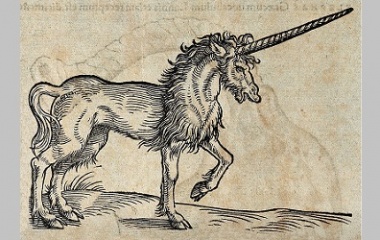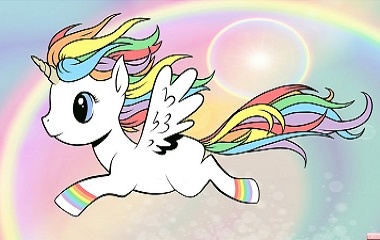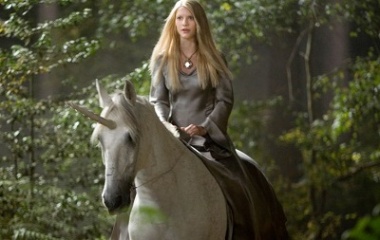What is a Unicorn?
Along with dragons, mermaids, and fairies, Unicorns have been basking in folklore’s brightest spotlight for thousands of years. From the get-go, they have been idolized for their independence and grace.
Characteristics
Physical Description
Today, Unicorns with pearly bodies and long, spiral-cut horns dominate the public’s imagination, but history reveals a parade of creatures of all shapes and sizes.
The Japanese dreamed up a form of Unicorn long before the luminous white beauty of the western world existed. This creature, called a qilin, had the body of a deer and the magnificent, rainbow scales of a dragon. A long horn sprouted from the center of its forehead, and it was so light-footed that not a single blade of grass was crushed under its hooves.
Later, the ancient Greeks took a stab at describing Unicorns, which they believed lived in the far east. They described a creature with a snow-white donkey body, a dark red head, cloven hooves, and a two-foot-long horn that was white at the base, black in the middle, and bright red at the tip.
During the Middle Ages, small, goat-like Unicorns became popular in paintings and tapestries. They were usually white or cream colored, with cloven hooves and a tuft of beard under their chins. Their manes and tails remained silky, like a horse, and their horns remained long and dangerous.
In the thirteenth century, Marco Polo misidentified a rhinoceros as a Unicorn and reported that the creatures were not at all as charming as folklore had made them out to be. He declared that they were huge, lumbering beasts with coarse hair, who liked to wallow in mud and filth. For a short time, natural historians accepted his description, disappointing as it was.
A smattering of other traits have been added and chipped off the fable over the years: lion’s tails, boar’s tails, elephant feet, branched horns. Still, by the eighteenth century, the Unicorn’s image was cemented into the majestic form that we know and love today.
Personality
Unicorns may look like something you could turn into a trophy pet, but they are wild animals at heart. Highly independent, they can easily elude the grasp of humans. They are elusive, and considering their dazzling beauty, they do an amazing job at blending into their surroundings. When they are spotted, they run away. In the rare case that a Unicorn is cornered, it will fight—and fight hard—for its freedom.
Still, these lofty creatures have a weakness: innocence. Pure-hearted and noble as they are, they are constantly searching for companions whose character is as spotless as their own. A sweet, innocent maiden can almost always lure a Unicorn out of hiding. If he likes her well enough, he might even lie down to nap with his head in her lap. Unfortunately, many Unicorns never wake up from these naps. They are slaughtered by hidden hunters, who used the maiden for bait.
Special Abilities
Even in their most unintimidating, goat-like form, Unicorns are powerful animals. They can outrun any predator—a fact which is as likely to save the predator’s life as the Unicorn’s. A kick from an angry hoof can break bone, and a thrust from that beautiful horn can destroy internal organs.
Yet, according to legend, masses of hunters chose to pursue this deadly prey. Why? Their horns could be made into a magical substance called alicorn, which had fantastic healing properties. It could neutralize any poison, purify water, and cure the most dangerous contagious fevers, including the plague. During the Renaissance, kings paid the equivalent of tens of thousands of dollars for materials that they believed were alicorn, and royal apothecaries ground them into a drinkable powder or carved goblets out of them.
Cultural Representation
Origin
The earliest traces of the Unicorn emerge in stone tablets and seals from the Indus Valley Civilization, around 2500 BC. Although some of these images might be profile-shots of bulls or antelopes, which only reveal one horn, other images don’t match up well with any known species, suggesting that the Indan people might have been the first to dream up unicorns.
Thousands of years later, in 4 BC, a Greek doctor named Ctesias set up on a voyage through Persia. Along his way, he picked up stories from Persian and Indian travelers about their native animals, and he was quick to spread the stories around Greece when he returned. The first description of a Unicorn is found in his book, Indika. Natural historians including Aristotle and Pliny the Elder jumped on the idea and included theories about the Unicorn in their books as well, lending clout to the newborn fable.
Romans inherited Unicorns from the Greek and handed them down to Europe, where they flourished in bestiaries, heraldry, paintings, and tapestry. Christianity helped fuel the Unicorn’s popularity by name-dropping it into the Bible and likening it to the Christ child.
Hoaxes
Throughout history, many attempts have been made to conjure up evidence that Unicorns really do walk among us. Whether these hoaxes were created to attract attention, humble scientists, sell tickets, or simply delight the world of believers, they all left their marks.
From the middle ages well into the eighteenth century, Europe saw a thriving trade of fake “Unicorn horns.” The horns were ground into medicinal powder, carved into scepters or goblets for the wealthy, and even used to build the Danish throne. Most of the horns were, in reality, taken from narwhals. A few were taken from antelope, oryx, elands, and rhinoceroses.
In 1635, a German mayor designed a ploy that would draw tourists to his small town. He selected prehistoric bones from an ongoing cave excavation and cobbled them together to look like a Unicorn skeleton. His skeleton was so well crafted that many scientific skeptics even switched to the “believer” camp, so everyone was disappointed when the skeleton was revealed as a hoax. In later years, more fake skeletons would be “unearthed,” but none of them managed to gain as much good-repute as the first.
When fossilized remains failed to excite a crowd, some enthusiasts began looking for ways to produce real, live Unicorns. In 1933, a scientist at the University of Maryland managed to surgically fuse the horns of a one-day old calf, so that they grew into a single, long horn in the center of his forehead. An occult enthusiast named Oberon Zell read Dove’s notes and managed to recreate the technique in a species of hybrid goat which he had bred himself. He sold “Unicorns” to the likes of Barnum and Bailey and the Ringling Brothers. The biggest star was Lancelot, a white goat luxurious, curly fur and a single horn smack in the center of his forehead. Lancelot drew a huge, cooing audience to the circus and was even examined, with x-rays, by a group of incredulous scientists, who ended in giving him the thumbs up.
Explanation
Although plenty of hucksters have tried to fake Unicorns, not all reports can be dismissed as hoaxes. Something, after all, must have inspired the legend!
Most scholars believe that Ctesias’ Unicorn, the first one introduced to western civilization, was a confused description of an Indian rhinoceros. During his travels, Ctesias encountered many Indian people and gathered descriptions of many exotic animals. He might have spliced together the powerful, single-horned rhinoceros with a more graceful creature, like a type of ox or antelope. Over time, western folklore polished the Unicorn into a more and more beautiful creature, until it was unrecognizable as a rhinoceros.
Alternatively, explorers and herdsmen might have encountered bulls, sheep, oryx, eland, or antelope with one horn severely damaged, even broken off, so that they appeared to have a single-horn. Genetic disorders, which are surprisingly common in some populations, might have also produced creatures who were born with a single, fused horn.
Unicorn






No comments:
Post a Comment